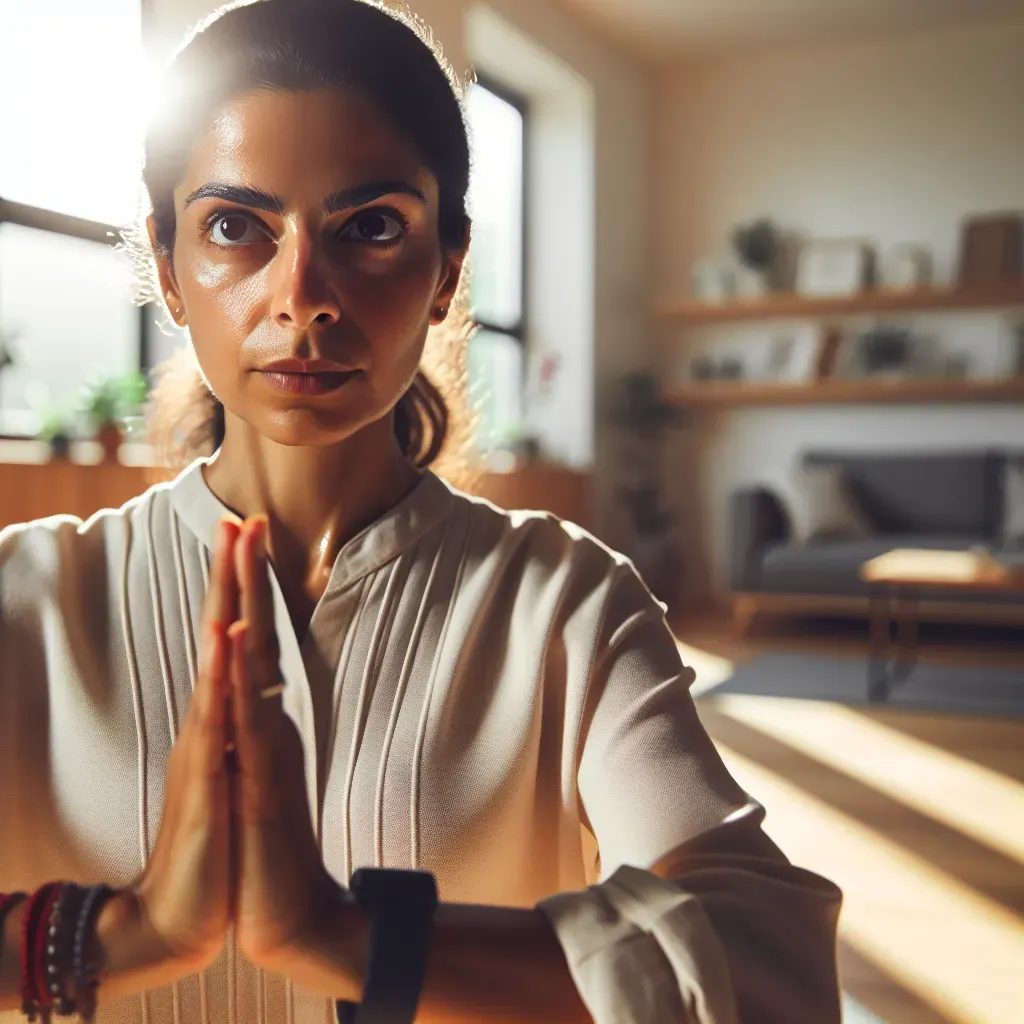The Mindful Odyssey: Navigating Yoga Nidra vs. Meditation for Inner Peace
Table of Contents
1. Introduction
2. Round 1: The Power Nap Showdown
3. Round 2: The Brain Booster Bout
4. Round 3: The Stress Buster Showdown
5. Round 4: The Healing Throwdown
6. Round 5: The Sleep Quality Showdown
7. Conclusion
Feeling torn between two paths to tranquillity—Yoga Nidra and meditation—is a relatable struggle in the quest for serenity. Imagine a day filled with relentless stress, where finding a moment of calm feels like a distant dream. In such moments, the decision between sinking into the soothing embrace of Yoga Nidra or embracing the timeless tranquillity of meditation can feel weighty, like a battle for sanity itself.
You might wonder, "Why complicate relaxation?" Understandably, simplicity beckons. However, exploring the nuances of these mindfulness practices promises empowerment and enlightenment. Through understanding the depths of Yoga Nidra and the traditions of meditation, you can unlock a journey towards profound inner peace. This exploration will enlighten, empower, and perhaps even bend the confines of your mind.
Let's embark on this odyssey together. By delving into the heart of mindfulness, we'll unravel the mysteries of Yoga Nidra and meditation. Through this exploration, you'll emerge armed with the insight to choose your unique path to tranquillity. So, buckle up, fellow seekers of serenity, for we are about to navigate the terrain where relaxation meets revelation.
The Power Nap Showdown
Picture this: it’s 3 PM, you’ve been grinding all day, and your eyelids feel like they're made of lead. You're desperate for a power nap, but who has time for that? Enter Yoga Nidra, the ultimate nap hack. In just 20 minutes, it promises to rejuvenate your mind and body, leaving you feeling as refreshed as if you'd slept for hours.
Now, you might be thinking, "But how can lying down with my eyes closed possibly be as restorative as a full night's sleep?" Fair question. Let me break it down for you. During a Yoga Nidra session, you enter a state of deep relaxation, where your brain waves slow down, and your body enters a state of restorative rest. It’s like hitting the reset button on your brain, giving you a second wind to tackle whatever the day throws at you.
But here’s the kicker: while you’re in this blissful state of relaxation, your subconscious mind is wide awake and ready to play. It’s like slipping into a secret garden of creativity and inspiration. You might find yourself coming up with solutions to problems you didn’t even know you had or tapping into a wellspring of ideas you never knew existed.
Contrast that with meditation, which can also induce a state of deep relaxation, but without the guarantee of a power nap-like boost. Sure, you might feel calm and centred after a meditation session, but will you have the same pep in your step as if you'd just woken up from a nap? Probably not.
So, if you’re looking for a quick pick-me-up to get you through the rest of the day, Yoga Nidra might just be your new best friend. It’s like hitting the snooze button on life and waking up feeling like a million bucks. But hey, don’t take my word for it. Give it a try and see for yourself.
The Brain Booster Bout
Ever feel like your brain is running on empty? Like you’re stuck in a mental fog and can’t seem to find your way out? We’ve all been there. But fear not, my friend, because help is at hand in the form of Yoga Nidra and meditation.
Let’s start with Yoga Nidra. You might be wondering, "How can lying down and listening to someone talk help me think more clearly?" It’s a valid question, and the answer lies in the way Yoga Nidra activates different parts of your brain. When you enter a state of deep relaxation, your brain waves slow down, allowing you to access your subconscious mind. It’s like flipping a switch and turning on the lights in a dark room.
Once you’re in this state, your brain becomes a playground for creativity and problem-solving. You might find yourself coming up with innovative solutions to challenges that have been plaguing you for weeks or uncovering hidden insights that lead to breakthroughs in your work or personal life.
But here’s where it gets interesting. While Yoga Nidra excels at tapping into your subconscious mind, meditation shines in its ability to sharpen your focus and enhance your cognitive function. When you meditate, you’re training your brain to stay present and alert, like a ninja ready to pounce at a moment’s notice.
By practising meditation regularly, you can strengthen the neural pathways associated with attention and concentration, making it easier to stay focused and engaged in whatever you’re doing. It’s like upgrading your brain’s operating system to the latest version, complete with enhanced features and improved performance.
So, if you’re looking to give your brain a boost, why not try both Yoga Nidra and meditation? Think of it like cross-training for your mind. By incorporating elements of both practices into your daily routine, you can unlock a whole new level of mental clarity and agility. Who knows? You might just become the next Einstein.
The Stress Buster Showdown
Stress. It’s the silent killer lurking in the shadows, waiting to pounce when you least expect it. Whether it’s work deadlines, family drama, or just the general chaos of life, we all have our triggers. But fear not, my friend, because help is at hand in the form of Yoga Nidra and meditation.
Let’s start with Yoga Nidra. You might be thinking, "How can lying down and listening to someone talk possibly help me manage my stress?" It’s a fair question, and the answer lies in the way Yoga Nidra activates your body’s relaxation response. When you enter a state of deep relaxation, your nervous system switches gears from fight-or-flight mode to rest-and-digest mode, like a car shifting into cruise control.
As your body relaxes, so too does your mind, releasing tension and anxiety like a pressure valve being released. It’s like taking a deep breath after holding it in for way too long, allowing yourself to finally relax and let go of whatever’s been weighing you down.
But here’s the real kicker: while Yoga Nidra works wonders for managing stress at the moment, meditation takes it a step further by rewiring your brain’s stress response over time. When you meditate regularly, you’re reshaping your brain, strengthening the neural pathways associated with calmness and resilience.
It’s like building a fortress around your mind, protecting it from the onslaught of stress and negativity that life throws your way. Sure, it takes time and practice, but the payoff is well worth it. Imagine being able to face life’s challenges with grace and equanimity, no matter what curveballs they throw at you. That’s the power of meditation.
So, if you’re feeling overwhelmed by stress, why not give Yoga Nidra and meditation a try? Think of it like arming yourself with a double-barreled shotgun against stress, with Yoga Nidra providing immediate relief and meditation offering long-term resilience. Who knows? You might just emerge from the battlefield stronger and more resilient than ever before.
The Healing Throwdown
When it comes to healing, the mind is a powerful ally. But harnessing its full potential requires the right tools and techniques. That’s where Yoga Nidra and meditation come in.
Let’s start with Yoga Nidra. You might be wondering, "How can lying down and listening to someone talk possibly help me heal?" It’s a valid question, and the answer lies in the way Yoga Nidra taps into your body’s innate healing mechanisms. When you enter a state of deep relaxation, your body’s stress response switches off, allowing it to focus its resources on repairing and rejuvenating itself.
But here’s where it gets interesting. While Yoga Nidra excels at promoting physical healing, meditation shines in its ability to heal the mind and spirit. When you meditate regularly, you’re creating a safe space for emotional processing and release, like a pressure cooker venting steam.
By allowing yourself to sit with your thoughts and feelings without judgment, you can begin to unravel the tangled knots of trauma and pain that have been holding you back. It’s like untangling a ball of yarn, one knot at a time, until all that’s left is a sense of peace and wholeness.
So, if you’re looking to heal from illness or injury, why not give Yoga Nidra and meditation a try? Think of it like giving your body and mind a much-needed spa day, complete with massages, facials, and aromatherapy. Who knows? You might just emerge feeling like a whole new person.
The Sleep Quality Showdown
Ah, sleep. The holy grail of wellness. We all know we need it, but getting enough of it is another story. If you’re tired of tossing and turning all night, help is at hand in the form of Yoga Nidra and meditation.
Let’s start with Yoga Nidra. You might be thinking, "How can lying down and listening to someone talk possibly help me sleep better?" It’s a fair question, and the answer lies in the way Yoga Nidra promotes deep relaxation and stress relief. When you enter a state of deep relaxation, your body’s stress response switches off, allowing you to drift off into a blissful slumber.
But here’s where it gets interesting. While Yoga Nidra can help you fall asleep faster and stay asleep longer, meditation takes it a step further by regulating your sleep cycles and promoting restorative REM sleep. When you meditate regularly, you’re training your brain to let go of the day’s worries and slip into a state of deep relaxation, like a baby being rocked to sleep in its mother’s arms.
By quieting the mind and releasing tension from the body, you can create the ideal conditions for a restful night’s sleep. It’s like setting the stage for a magical journey into dreamland, where anything is possible and the worries of the day fade away.
So, if you’re tired of counting sheep and ready to reclaim your nights, why not give Yoga Nidra and meditation a try? Think of it like hitting the reset button on your sleep cycle, allowing you to wake up feeling refreshed and rejuvenated, ready to take on whatever the day throws at you. Who knows? You might just become one of those people who look forward to bedtime.
Choosing Your Path To Peace
Feeling a little overwhelmed by all this talk of Yoga Nidra and meditation? Hey, I get it. Making decisions isn’t always easy, especially when it comes to something as personal as mindfulness. You might be thinking, "Do I have to choose between these two? Can’t I just do both?" And you know what? That’s a perfectly valid question. After all, there’s no one-size-fits-all solution when it comes to finding inner peace.
But here’s the thing: whether you’re Team Yoga Nidra or Team Meditation, the most important thing is that you’re taking steps to prioritize your mental and emotional well-being. By exploring the benefits of both practices, you’re opening yourself up to a world of possibility, where relaxation and rejuvenation are just a breath away.
So, let me give you a little pep talk. You’ve made it this far, diving deep into the world of mindfulness and coming out the other side with a newfound sense of clarity and understanding. You’ve learned that Yoga Nidra is like a power nap for the soul, while meditation is a mental marathon that strengthens your resilience and focus.
But more than that, you’ve discovered that mindfulness isn’t just a buzzword or a fad. It’s a way of life, a journey of self-discovery and self-care that has the power to transform your entire existence. And you, my friend, are well on your way to unlocking its full potential.
So, as we bring this journey to a close, I want you to take a moment to pat yourself on the back. You’ve shown up for yourself in ways you never thought possible, and that’s something worth celebrating. Whether you choose to incorporate Yoga Nidra, meditation, or both into your daily routine, know that you’re choosing to prioritize your well-being and honour your inner truth.
And hey, if you ever find yourself doubting whether you’re on the right path, just remember this: you’ve got everything you need right here, inside you. So take a deep breath, trust yourself, and let your light shine bright. Because when it comes to finding peace and happiness, the only competition that matters is the one within yourself. And you, my friend, are already a champion.
People Also Asked
1. What is Yoga Nidra, and how does it differ from meditation?
Yoga Nidra is a guided relaxation practice that leads you into a state of deep relaxation while remaining conscious. Unlike meditation, which often involves focusing on the breath or a mantra, Yoga Nidra typically follows a specific script that guides you through various stages of relaxation.
2. What are the benefits of Yoga Nidra compared to meditation?
Yoga Nidra offers similar benefits to meditation, such as stress reduction, improved sleep, and enhanced mental clarity. However, some people find Yoga Nidra more accessible and effective for relaxation, as it allows them to effortlessly enter a state of deep relaxation without needing to quiet the mind.
3. Can I practice Yoga Nidra and meditation together?
Absolutely! Many practitioners find that combining Yoga Nidra with meditation enhances their overall mindfulness practice. You can start with a Yoga Nidra session to relax your body and mind, then transition into a meditation practice to deepen your focus and awareness.
4. How often should I practice Yoga Nidra or meditation to see results?
The frequency of practice varies from person to person, but consistency is key. Aim to practice Yoga Nidra or meditation at least a few times per week to experience the benefits. You may find that practising daily yields the best results, but listen to your body and adjust accordingly.
5. Can Yoga Nidra or meditation help with anxiety and stress?
Yes, both Yoga Nidra and meditation are effective tools for managing anxiety and stress. By promoting relaxation and reducing the body’s stress response, these practices can help you cultivate a greater sense of calm and resilience in the face of life’s challenges.
6. Is Yoga Nidra suitable for beginners?
Absolutely! Yoga Nidra is accessible to people of all experience levels, including beginners. Since it doesn’t require any special skills or flexibility, it’s a great starting point for those new to mindfulness practices.
7. What if I fall asleep during Yoga Nidra?
Falling asleep during Yoga Nidra is common and perfectly okay. It’s often seen as a sign that your body and mind need rest. If you find yourself drifting off to sleep, simply allow it to happen and trust that your subconscious mind is still absorbing the benefits of the practice.
8. Can Yoga Nidra or meditation help improve my sleep quality?
Yes, both Yoga Nidra and meditation have been shown to improve sleep quality by promoting relaxation and reducing stress levels. Incorporating these practices into your bedtime routine can help you unwind and prepare your body and mind for restful sleep.
9. Are there any contraindications for practising Yoga Nidra or meditation?
While Yoga Nidra and meditation are generally safe for most people, it’s always a good idea to consult with a healthcare professional if you have any underlying health conditions or concerns. Additionally, some people may find certain meditation techniques challenging, so it’s important to listen to your body and modify the practice as needed.
10. Which practice is better: Yoga Nidra or meditation?
There is no one-size-fits-all answer to this question, as both Yoga Nidra and meditation offer unique benefits and experiences. The best practice for you depends on your personal preferences, goals, and individual needs. Experiment with both and see which resonates most with you!
Recommended Products
1. Yoga Nidra Guided Meditation Audio Tracks: Promote audio recordings or guided meditation sessions specifically designed for Yoga Nidra practice.
2. Meditation Cushions and Bolsters: Recommend comfortable cushions and bolsters to enhance the meditation experience, whether practising Yoga Nidra or traditional meditation.
3. Mindfulness Journals: Encourage readers to explore their thoughts and reflections through mindfulness journaling, complementing their Yoga Nidra or meditation practice.
4. Essential Oil Diffusers: Suggest essential oil diffusers and calming essential oil blends to create a tranquil atmosphere during meditation or Yoga Nidra sessions.
5. Sleep Masks: Offer sleep masks to enhance relaxation and improve sleep quality, especially for those interested in the sleep benefits of Yoga Nidra.
6. Meditation Apps: Promote meditation apps that offer guided sessions, including specific programs for both Yoga Nidra and traditional meditation.
7. Yoga Mats: Recommend high-quality yoga mats for comfortable practice during Yoga Nidra sessions.
8. Stress Relief Supplements: Highlight natural supplements or herbal remedies known for promoting relaxation and stress reduction, complementing mindfulness practices.
9. Relaxation Music Albums: Recommend soothing music albums or playlists designed to enhance relaxation and meditation experiences.






